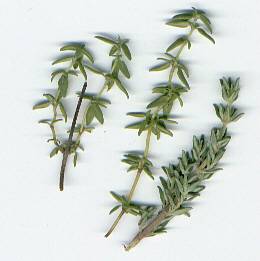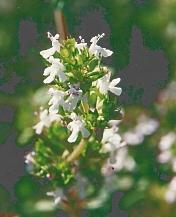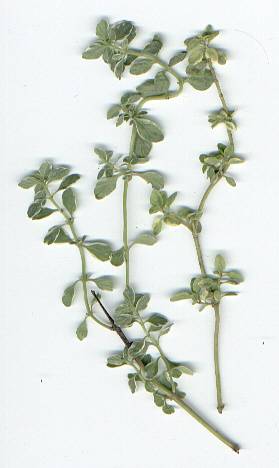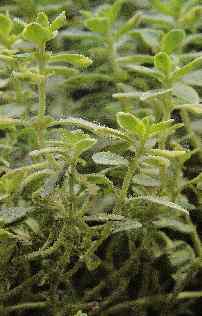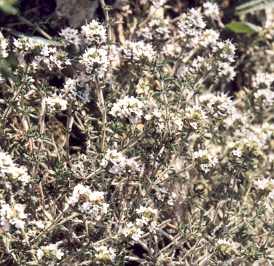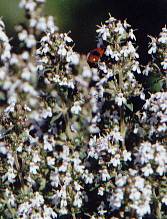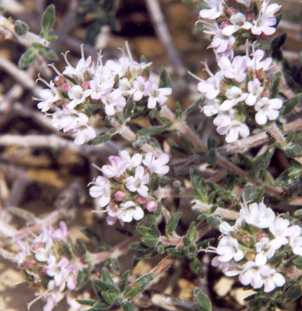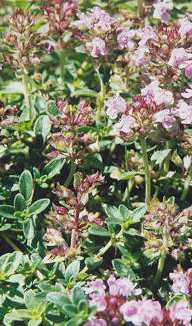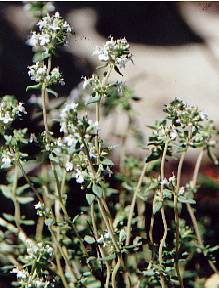
| |
Flowering garden thyme
|
|
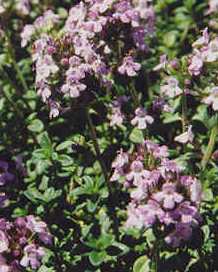
| |
Lemon thyme, monocoloured variety
|
|
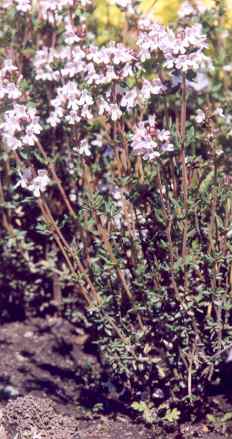
|
|
Flowering thyme
|
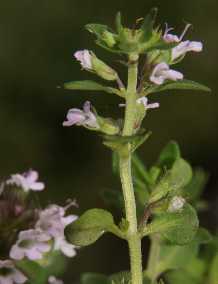
|
|
Thyme flowers
|
Thyme is an important spice of European cuisines, especially
in South Europe. It is especially typical for France, where fresh branches of
thyme, tied up into bundles together with other fresh herbs, are added to
soups, sauces and stews, being removed before serving (
bouquet
garni, see
parsley).
Dried thyme is also a part of the herbes de Provence, a
spice mixture from Provence (Southern France; see lavender). Thyme is furthermore popular in the
non-European parts of the Mediterranean; for example, the Jordan condiment zahtar (see sumac) contains thyme as
vital aroma. Another example is dukka [دقه], a typical spice mixture
of Egypt. It is a slightly salted combination of toasted seeds (sesame, hazelnut; in Egypt, also the young peach kernels, which are similar to almonds),
coriander, cumin, black pepper and thyme, predominantly used to flavour
meat. Egyptian white bread eaten together with olive oil and dukka gives a very
simple, but delicious meal.
In Central Europe, Thyme is most used for soups, fish, meat, poultry and eggs.
Thyme, particularly lemon thyme, is a great addition to herbal vinegar (see dill). Industrially, thyme is often combined with marjoram for sausages and goes well with bay or boldo leaves.
Cheese is sometimes flavoured with thyme.
In Britain, thyme is the most popular culinary herb besides
mint. It also plays am important rôle
in the cooking of the United States, particularly of the East Coast.
The Creole cuisine of New Orleans
(the only true regional cuisine of the US, see also sassafras) is particularly famous for its extensive
use of thyme. A cooking technique peculiar to Creole cooking is the so-called
blackening: Meat or fish fillets are dipped into molten butter, then
coated with a spice mix and then fried very quickly at high temperature in a
heavy skillet, without any further oil. The spices should become dark brown
(blackened
),
but charring is not, in any case, desired. A typical spice mix for this purpose
might, besides quite much salt and thyme, contain medium-hot paprika, white pepper,
thyme, oregano, garlic
and onion powder.
Thyme’s popularity extends even more South: it is common in Central American
cuisine. Jerk, the most famous culinary export item of Jamaica (besides
rum, of course), often contains thyme; see allspice
for more information.
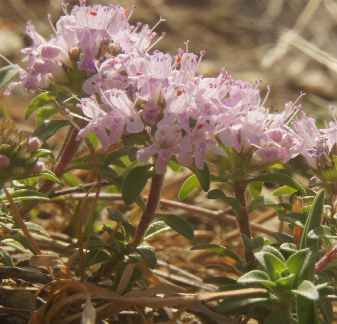
|
|
This thyme (probably Th. linearis) I found wild in the Indian Himalayas
|
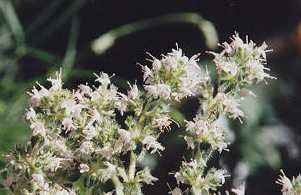
|
|
A pubescent (hairy) thyme variety called wood pine
|
There are various opinions concerning the question whether herbs should be
better used fresh or dried. Several herbs lose their flavour partially or in
full when dried: Examples include coriander,
parsley,
tarragon, bear’s garlic
and dill, but also
curry leaves and
lemon grass. Advanced drying technology may
in some cases preserve the original flavour, at least in part; but these
herbs are, even with best dehydration equipment, always better used fresh
than dried. Better preservation may be achieved with special preparations,
(e. g., pesto made from basil).
The loss of fragrance is mainly due to two causes: Aroma components escape to
the air (evaporation) or may be chemically destroyed, mainly by oxidation.
Some herbs, however, show a different, even paradoxical, behaviour: Their
spiciness
actually increases when dried. Sometimes, one reads an explanation of that
effect stating that on drying, structures in the plant tissue collapse which
results in increased mobility and availability of the essential oil which can
now easier diffuse into the foods. Besides thyme, that phenomenon can be
observed in oregano and
rosemary: For all three herbs, the (skilfully)
dried herb surpasses the fresh one in intensity by a factor of two or three.
Fresh thyme is not only less intensive that dried thyme, but is has a more soft
flavour, less smoky, and fits perfectly to Mediterranean vegetables (e. g., ratatouille, see lavender) or fish.
Dried thyme, on the other hand, has a dominating smokiness that comes best in
spicy foods, particularly meats (e. g., in the blackening procedure
referred to above).




